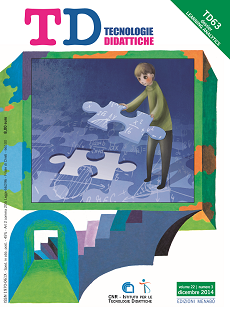Learning Analytics: fattori trainanti, sviluppi e storie
Contenuto principale dell'articolo
Abstract
Dettagli dell'articolo
Gli autori che pubblicano su questa rivista accettano le seguenti condizioni:
- Gli autori mantengono i diritti sulla loro opera e cedono alla rivista il diritto di prima pubblicazione dell'opera, contemporaneamente licenziata sotto una Licenza Creative Commons CC BY 4.0 Attribution 4.0 International License.
- Gli autori possono aderire ad altri accordi di licenza non esclusiva per la distribuzione della versione dell'opera pubblicata (es. depositarla in un archivio istituzionale o pubblicarla in una monografia), a patto di indicare che la prima pubblicazione è avvenuta su questa rivista.
- Gli autori possono diffondere la loro opera online (es. in repository istituzionali o nel loro sito web) prima e durante il processo di submission, poiché può portare a scambi produttivi e aumentare le citazioni dell'opera pubblicata (Vedi The effect of Open Access).
Riferimenti bibliografici
Granovetter, M. S. (1973). The strength of weak ties. The American Journal of Sociology, 78(6), 1360-1380.
Haythornthwaite, C. (2006). Facilitating collaboration in online learning. Journal of Asynchronous Learning Networks, 10(1), 7-24.
Haythornthwaite, C., & De Laat, M. (2010). Social networks and learning networks: using social network perspectives to understand social learning. Proceedings of the 7th International Conference on Networked Learning, (pp. 183- 190). Aalborg, Denmark.
Heer, J., Viégas, F. B., & Wattenberg, M. (2009). Voyagers and voyeurs: Supporting asynchronous collaborative visualization. Communications of the ACM, 52(1), 87-97.
Johnson, L., Smith, R., Willis, H., Levine, A., & Haywood, K. (2011). The Horizon Report: 2011 Edition. Austin, Texas: The New Media Consortium. Johnson, L., Adams, S., & Cummins, M., (2012). The NMC Horizon Report: 2012 Higher Education Edition. Austin, Texas: The New Media Consortium.
Jovanovic, J., Gasevic, D., Brooks, C., Devedzic, V., Hatala, M., Eap, T., & Richards, G. (2008). LOCO- analyst: semantic web technologies in learning content usage analysis. International Journal of Continuing Engineering Education and Life Long Learning, 18(1), 54-76.
Landauer, T., Foltz, P., & Laham, D. (1998). An introduction to latent semantic analysis. Discourse Process, 25(2-3), 259-284.
Lave, J., & Wenger, E. (1991). Situated Learning: Legitimate Peripheral Participation. Cambridge: Cambridge University Press.
Long, P., & Siemens, G. (2011). Penetrating the fog: analytics in learning and education. EDUCAUSE Review, 46(5), 31-40.
Manyika, J., Chui, M., Brown, B., Bughin, J., Dobbs, R., Roxburgh, C., & Hung Byers, A. (2011). Big Data: The Next Frontier for Innovation, Competition and Productivity. McKinsey Global Institute.
Mazza, R., & Dimitrova, V. (2004). Visualising student tracking data to support instructors in web-based distance education. Proceedings of the 13th international World Wide Web conference on Alternate track papers & posters, (pp. 154-161). New York, NY, USA.
Mazza, R., & Dimitrova, V. (2007). CourseVis: A graphical student monitoring tool for supporting instructors in web-based distance courses. International Journal of Human-Computer Studies, 65(2), 125-139.
Mazza, R., & Milani, C. (2004). GISMO: a graphical interactive student monitoring tool for course management systems. The T.E.L.’04 Technology Enhanced Learning’04 International Conference. Milan, Italy.
Mazzola, L., & Mazza, R. (2011). Visualizing learner models through data aggregation: a test case. Proceedings of the Red-Conference, Rethinking Education in the Knowledge Society, (pp. 372- 380). Monte Verità, Switzerland.
McIntosh, N. (1979). Barriers to implementing research in higher education. Studies in Higher Education, 4(1), 77-86.
Mercer, N. (2000). Words and Minds: How We Use Language To Think Together. London: Routledge.
Mercer, N., & Wegerif, R. (1999). Is “exploratory talk” productive talk?, Learning with computers: analysing productive interaction. New York: Routledge.
Mitchell, J., & Costello, S. (2000). International e- VET Market Research Report: A Report on International Market Research for Australian VET Online Products and Services. Sydney, Australia: John Mitchell & Associates and Education Image.
Norris, D. B. (2008). Action analytics: measuring and improving performance that matters in higher education. EDUCAUSE Review, 43(1).
Norris, D., Baer, L., & Offerman, M. (2009). A national agenda for action analytics. Paper presented at the National Symposium on Action Analytics.
Rheingold, H. (1993). The Virtual Community: Homesteading on the Electronic Frontier. Reading, Massachusetts: Addison-Wesley.
Romero, C., & Ventura, S. (2007). Educational data mining: A survey from 1995 to 2005. Expert Systems with Applications: An International Journal, 33(1), 135-146.
Romero, C., Ventura, S., & García, E. (2008). Data mining in course management systems: Moodle case study and tutorial. Computers & Education, 51(1), 368-384.
Siemens, G. (2010, August 25). What Are Learning Analytics?. [web log post] Elearnspace.org. Retrieved from http://www.elearnspace.org/ blog/2010/08/25/what-are-learning-analytics/
Suthers, D., Vatrapu, R., Medina, R., Joseph, S., & Dwyer, N. (2008). Beyond threaded discussion: Representational guidance in asynchronous collaborative learning environments. Computers & Education, 50(4), 1103-1127.
Thomason, N., & Rider, Y. (2008). Cognitive and pedagogical benefits of argument mapping: L.A.M.P. guides the way to better thinking. In A. Okada, S. Buckingham Shum, & T. Sherborne, Knowledge Cartography: Software Tools and Mapping Techniques (pp. 113-130). London: Springer.
Tinto, V. (1997). Colleges as communities: taking research on student persistence seriously. The Review of Higher Education, 21(2), 167-177.
van Barneveld, A., Arnold, K. E., & Campbell, J.P. (2012). Analytics in Higher Education: Establishing a Common Language. EDUCAUSE.
van Ham, F. Schulz, H.J., & Dimicco, J.M. (2009). Honeycomb: Visual Analysis of Large Scale Social Networks. In T. Gross et al. (Eds.), Human- Computer Interaction - INTERACT 2009, Lecture Notes in Computer Science: Vol. 5727, (pp. 429-442). Berlin, Heidelberg, DE: Springer. doi: 10.1007/978-3-642-03658-3_47
Verbert, K., Drachsler, H., Manouselis, N., Wolpers, M., Vuorikari, R., & Duval, E. (2011). Dataset-driven research for improving recommender systems for learning. Proceedings of the 1st International Conference on Learning Analytics and Knowledge, (pp. 44-53). Banff, Alberta, Canada.
Vygotskyij, L. S. (1978). Mind in Society: The Development of Higher Psychological Processes. Cambridge, MA: Harvard University Press.
Wenger, E. (1998). Communities of Practice: Learning, Meaning and Identity. Cambridge: Cambridge University Press.
Wolpers, M., Najjar, J., Verbert, K., & Duval, E. (2007). Tracking actual usage: the attention metadata approach. Journal of Educational Technology and Society, 10(3), 106-121.
Zaïane, O. (2001). Web usage mining for a better web-based learning environment. Proceedings of the 4th IASTED International Conference on Advanced Technology for Education (CATE’01), (pp. 60-64). Banff, Canada.

